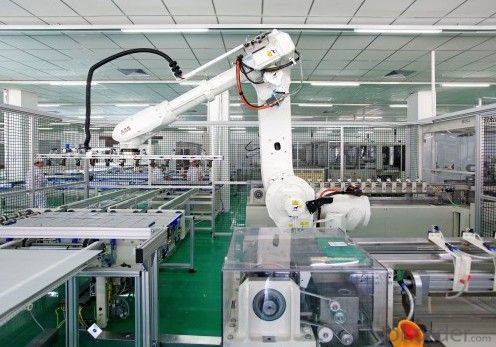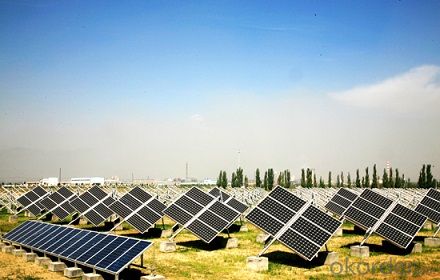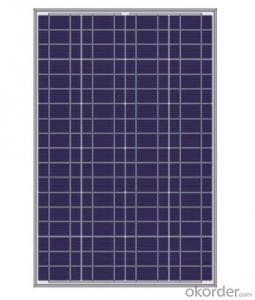Polycrystalline Silicon Solar Panel Model CR095P-CR080P
- Loading Port:
- Tianjin
- Payment Terms:
- TT OR LC
- Min Order Qty:
- 5 pc
- Supply Capability:
- 100 pc/month
OKorder Service Pledge
OKorder Financial Service
You Might Also Like
1. Structure of Polycrystalline Silicon Solar Panel Model CR095P-CR080P
Solar modules, which are widely used in ground mounted utility-scale PV plants, large-scale and small civil and commercial power generating system such as BIPV combined to the grid, roof-mounted PV power system, rural electrification, communications, emergency auxiliary power. Solar PV module is comprised of some solar cells which are connected in serial with high efficiency and enhanced reliability. The solar cells are laminated between sheets of ethylene vinyl acetate (EVA) and high-clarity low-iron tempered glass, and sealed by the silica gel in a anodized aluminum frame . The solar module has got the professional certificate as following:

2. Main Features of Polycrystalline Silicon Solar Panel Model CR095P-CR080P
· Esthetic appearance, with stands high wind-pressure and snow load, and easy installation
· Water resistant junction box
· Design to meet unique demand of customer
· 25 year poweroutput warranty
3.Polycrystalline Silicon Solar Panel Model CR095P-CR080P Images


4. Polycrystalline Silicon Solar Panel Model CR095P-CR080P Specification
Module type | CR095P | CR090P | CR085P | CR080P |
Cell type | 156mm × 156mm | |||
No. of cells and connections | 24( 4×6 ) | |||
Dimension of module (mm) | 1018×665×35 | |||
Weight of module (kg) | 7.8 | |||
Maximum Power (Pm) | 95W | 90W | 85W | 80W |
Open-circuit voltage (Voc) | 22.0V | 21.8V | 21.6V | 21.4V |
Short-circuit current (Isc) | 5.77A | 5.60A | 5.50A | 5.48A |
Volatage at Pmax (Vmp) | 18.0V | 17.8V | 17.4V | 17.0V |
Current at Pmax (Imp) | 5.28A | 5.06A | 4.90A | 4.72A |
Maximum system voltage | 715VDC | |||
Operating temperature | -40℃ to +85℃ | |||
5. FAQ
(1) Can you offer the test report of the module?
Sure. All the solar modules must pass necessary tests including EL test and ultra-red test and other visual test of the apperance, and the test report presents all the detailed data of the modules.
(2) How to confirm about the quantity and the type of solar module?
It depends on the solar system where you want to put into use the solar modules. We have experienced engineers to design for your order and you need to give more information to fix the details.
(3) How long will you deliver the solar modules?
We need to purchase the materials according to the list confirmed by you and put into production, and we will do our best to get your satisfaction.
- Q:Photo-Voltaic solar panels are very expensive. Most of a home's energy needs are for heating water, heating and air-conditioning. All of these can be met with thermal solar collectors which are much less expensive. The thermal solar panels would heat water stored in a hot water tank which then can be used as hot water, to heat the home, or as the heat source to a Lithium Bromide Absorption chiller to air-condition a home. With the base line needs met without expensive panels and without inefficient energy conversions, only a small Photo-Voltaic array would be needed for the remaining power needs and since those needs are variable, there would still be power to sell to the grid.
- you completely nailed it!! speaking about large buildings, it would benefit one to do a little more research. my company just installed a 640 collecter system on a million sq foot building. it consists of a absorption chiller (which uses no coolant, just water a silica gel beds, runs of the power of its controller, thats it) 27,000 gallon tank. chiller feeds 2 rotation units and 2 large office spaces for heat and cool. payback expected at less than 5 years. we will expand this system another 200 collectors. residential installs, if tax credits used, achieve 5-7 year payback pending domestic hot water only or dhw and space heating. thermal collectors actually produce more energy than pv panels do, therefore more bang for your buck, also as i hope you all know, pv has around 25% eff, thermal has 95%. also to say the tech part is gone, we use flowmeters that calculate carbon offsets, energy saved, money saved etc...all located in a wireless monitor for the consumer to enjoy.
- Q:I'm doing a science fair experiment with a tiny two-inch solar panel that only gives off like .5 volts of energy, but I need to know how many volts an average sized solar panel (like one you'd get to run your house) would produce. And how many panels do people usually get?
- You should read up on the different electrical units. You say .5 volts of energy, but this makes little sense. Energy is measured in Joules. Power in Watts. Solar panels will produce different voltages and currents, depending on the amount and angle of sunlight hitting them. Power = volts * amps. Before installing solar panels a home owner should do an energy audit to find out how much power they currently use - and how much that could be reduced with some easy changes. Solar panels are expensive, so it makes sense to reduce the amount that you need to install. In some places you can sell extra power back to your utility - so having extra panels might give you some small amount of money back - but this is rarely enough to justify the cost of the extra panels. I put 28 panels on my house (see picture in source URL). My utility has tiered pricing for electricity (first few kWh each month are cheap, but price for extra ones goes up in stages). My panels keep me from having to pay the higher rates.
- Q:Solar panels are all divided into these squares, forming a grid like pattern. Is it possible to have a single piece of solar panel?
- Solar cells are semiconductor devices like computer chips. Current manufacturing methods create small squares of semiconductors. Companies are researching ways to make thin film solar cells that can be painted on or manufactured in large, possibly flexible sheets, but so far the technology to do that is still more expensive than making little squares and then assembling them into big panels. That may change in the near future, but I can't be sure.
- Q:solar panels or light parts
- They make lights that have solar panels built into them. Due to the solar cell, they can sense when it gets dark and thus switch on the light automatically. Look at Northern Tool or Harbor Freight web sites for ideas.
- Q:Can solar panels be used in areas with high levels of electromagnetic radiation?
- Yes, solar panels can be used in areas with high levels of electromagnetic radiation. While electromagnetic radiation can potentially interfere with the functioning of electronic devices, solar panels are designed to withstand various environmental conditions. They are typically equipped with protective measures, such as grounding and shielding, to minimize the impact of electromagnetic radiation. Therefore, as long as the solar panels are installed correctly and maintained properly, they can continue to generate electricity efficiently even in areas with high levels of electromagnetic radiation.
- Q:What is the lifespan of solar panel batteries?
- The lifespan of solar panel batteries can vary depending on various factors such as the type and quality of the battery, usage patterns, and maintenance. On average, solar panel batteries generally last between 5 to 15 years. However, with proper care and regular maintenance, some high-quality batteries can last up to 20 years or more.
- Q:My electric bill per month averages 800 kWh per month. I am looking at 65W solar panels. How many panels would I need to make my bill come to zero? I realize I also need an inverter to convert dc to ac.
- Your local installer will estimate this much more precisely than I can. Your main problem, as I see it, is not that you need this many solar panels. Your main problem is that you consume WAY too much electricity. You should probably cut your energy consumption in half BEFORE you invest in solar because it will be way more economic to eliminate the main consumers than to generate that wasted energy. I, for example, need no more than 80kWh/month for a household of two.
- Q:How do solar panels affect roof maintenance?
- Solar panels can have both positive and negative effects on roof maintenance. On the positive side, solar panels can provide an added layer of protection to the roof by shielding it from harmful elements like UV rays, rain, and snow. This can help extend the lifespan of the roof and reduce the need for repairs. However, solar panels can also make roof maintenance more challenging as they need to be regularly cleaned and inspected to ensure optimal performance. Additionally, any repairs or maintenance work on the roof may require temporarily removing the panels, adding an extra step to the process.
- Q:how big of an solar panel do i need to power/charge my laptop?would one from canadian tire sell the right one?
- Yes. Basically, here's what you need (I'm keeping this general on purpose): The panels themselves -- how large an area depends on average power consumption and how much power you can get on average. That, in turn , depends on climate. You'd need more in Seattle than Tuscon, for example. I'd guess something in the neighborhod of 0 square feet. Depends also on haow many gadgets (printers, etc.) you have. You'll need a power storage system. Lithium gives you the best poser density (of off-the-shelf stuff) but an ordinary car battery works well and is reliable. And, of course, a control system to manage the power generation/storage/use so everything works together without that annoying smell that tells you you just cooked a few hundred bucks worth of equuipment! :)
- Q:I was just wondering what the minimum and maximm charging voltage and ampere is for li ion batteries. If i connect a solar panel, which only gets enough sunshine to generate voltage, will that still charge the battery, or would i have to series connect solar panels until they together reach 3,7volt?
- One lithium cell requires 4.2V to obtain its full charge, Never exceed 4.2V ! Output from solar panel if below 3.7V , nothing charge to lithium. Total charging time until the cell is full depending on the AH rate of cell and the charging current that solar panel can be provided. Suppose cell is rate 5AH, and the charging current from solar panel under full sun shine can maintain 0.5A ( use solar panel short circuit current rate from its specification as a reference ) , hence, 0 hours is enough. And be sure the solar panel can maintain 4.2V output at 0.5A . Remember, over charge lithium cell one time might reduce its life into half . Therefore, let the solar panel output passing through a precision regulator to maintain output is 4.2V is the best way, because, as cell reaches 4.2V , no more charging current is forced into cell ( automatic stop charging ). If you do not have the knowledge to make this simple variable voltage regulator with LM37K ( if you choose this way, buy solar panel output has at least 2V) , you may choose to do it manually by install a current meter and a variable resistor in series between the panel output to cell. By adjust the value of resistor, charging current can be controlled ( if you choose this way, buy solar panel output has as less as 6V ). Count the charging time with a clock and adjust the charging current from time to time to maintain 0.5A .
1. Manufacturer Overview |
|
|---|---|
| Location | |
| Year Established | |
| Annual Output Value | |
| Main Markets | |
| Company Certifications | |
2. Manufacturer Certificates |
|
|---|---|
| a) Certification Name | |
| Range | |
| Reference | |
| Validity Period | |
3. Manufacturer Capability |
|
|---|---|
| a)Trade Capacity | |
| Nearest Port | |
| Export Percentage | |
| No.of Employees in Trade Department | |
| Language Spoken: | |
| b)Factory Information | |
| Factory Size: | |
| No. of Production Lines | |
| Contract Manufacturing | |
| Product Price Range | |
Send your message to us
Polycrystalline Silicon Solar Panel Model CR095P-CR080P
- Loading Port:
- Tianjin
- Payment Terms:
- TT OR LC
- Min Order Qty:
- 5 pc
- Supply Capability:
- 100 pc/month
OKorder Service Pledge
OKorder Financial Service
Similar products
New products
Hot products
Related keywords





























